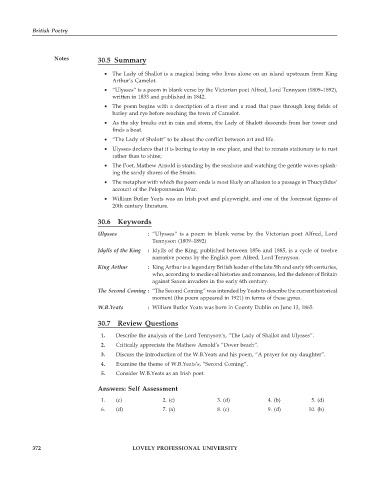Page 379 - DENG405_BRITISH_POETRY
P. 379
British Poetry
Notes 30.5 Summary
• The Lady of Shallot is a magical being who lives alone on an island upstream from King
Arthur’s Camelot.
• “Ulysses” is a poem in blank verse by the Victorian poet Alfred, Lord Tennyson (1809–1892),
written in 1833 and published in 1842.
• The poem begins with a description of a river and a road that pass through long fields of
barley and rye before reaching the town of Camelot.
• As the sky breaks out in rain and storm, the Lady of Shalott descends from her tower and
finds a boat.
• “The Lady of Shalott” to be about the conflict between art and life.
• Ulysses declares that it is boring to stay in one place, and that to remain stationary is to rust
rather than to shine;
• The Poet, Mathew Arnold is standing by the seashore and watching the gentle waves splash-
ing the sandy shores of the Straits.
• The metaphor with which the poem ends is most likely an allusion to a passage in Thucydides’
account of the Peloponnesian War.
• William Butler Yeats was an Irish poet and playwright, and one of the foremost figures of
20th century literature.
30.6 Keywords
Ulysses : “Ulysses” is a poem in blank verse by the Victorian poet Alfred, Lord
Tennyson (1809–1892)
Idylls of the King : Idylls of the King, published between 1856 and 1885, is a cycle of twelve
narrative poems by the English poet Alfred, Lord Tennyson.
King Arthur : King Arthur is a legendary British leader of the late 5th and early 6th centuries,
who, according to medieval histories and romances, led the defence of Britain
against Saxon invaders in the early 6th century.
The Second Coming : “The Second Coming” was intended by Yeats to describe the current historical
moment (the poem appeared in 1921) in terms of these gyres.
W.B.Yeats : William Butler Yeats was born in County Dublin on June 13, 1865.
30.7 Review Questions
1. Describe the analysis of the Lord Tennyson’s, “The Lady of Shallot and Ulysses”.
2. Critically appreciate the Mathew Arnold’s “Dover beach”.
3. Discuss the Introduction of the W.B.Yeats and his poem, “A prayer for my daughter”.
4. Examine the theme of W.B.Yeats’s, “Second Coming”.
5. Consider W.B.Yeats as an Irish poet.
Answers: Self Assessment
1. (c) 2. (c) 3. (d) 4. (b) 5. (d)
6. (d) 7. (a) 8. (c) 9. (d) 10. (b)
372 LOVELY PROFESSIONAL UNIVERSITY

